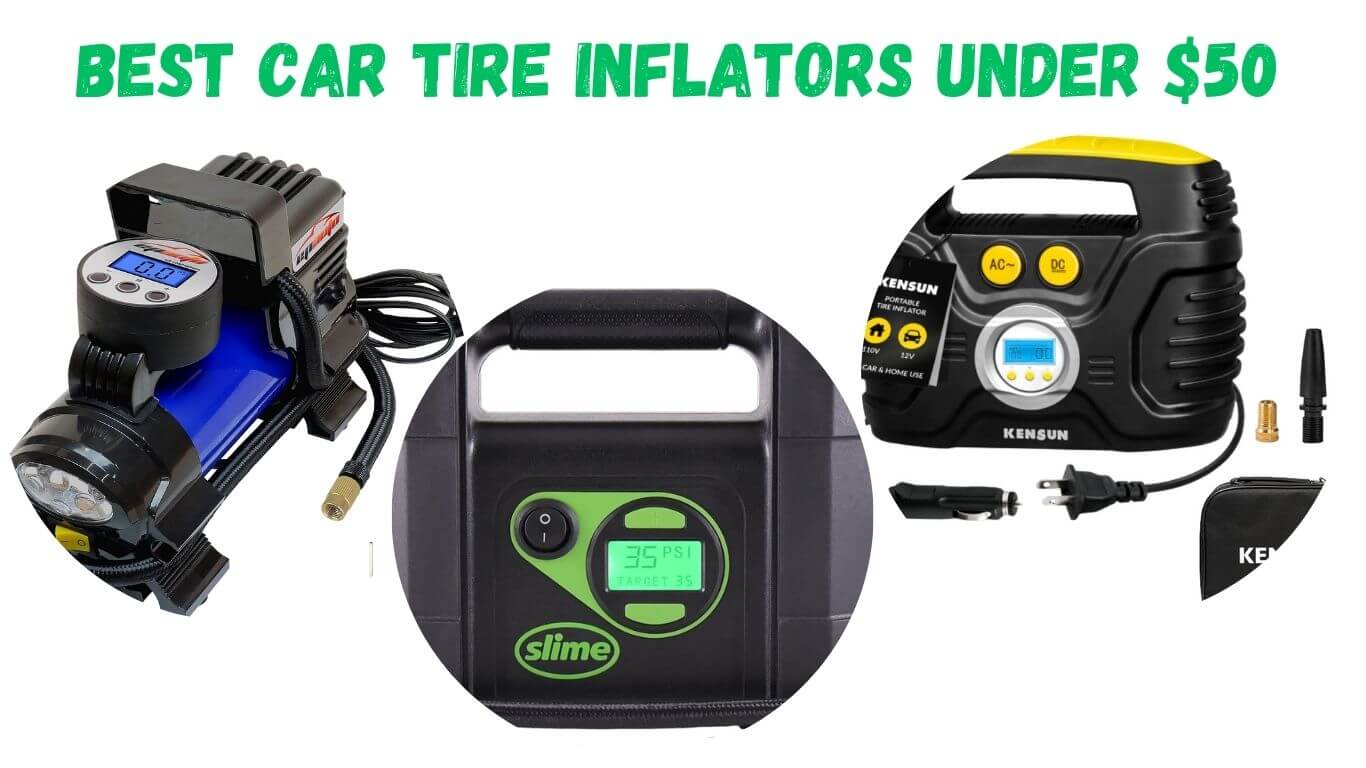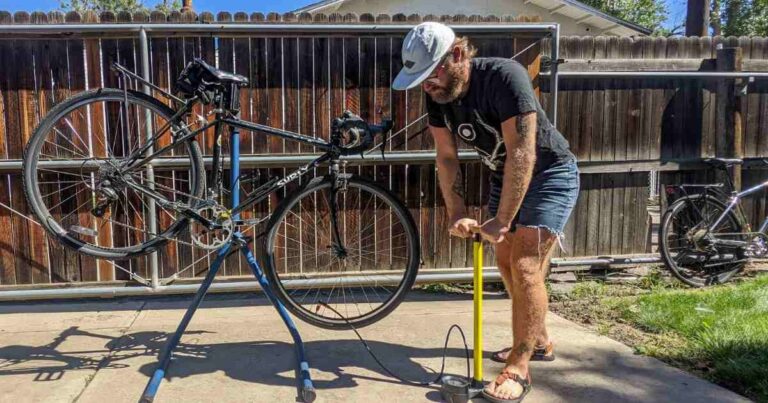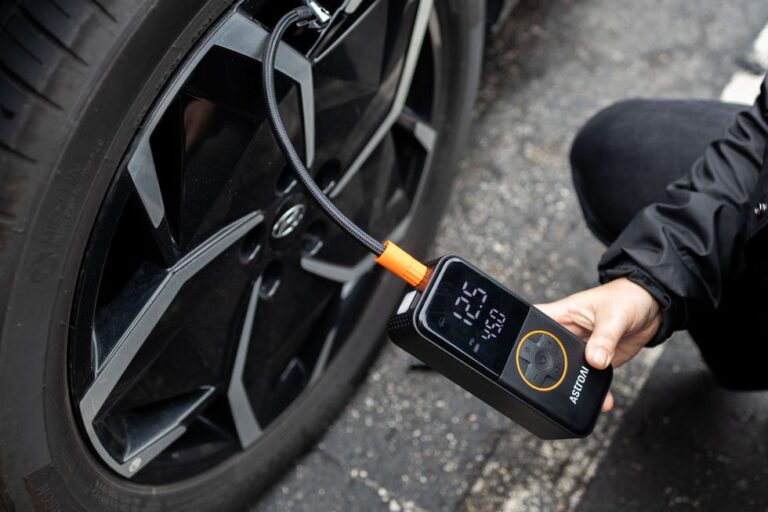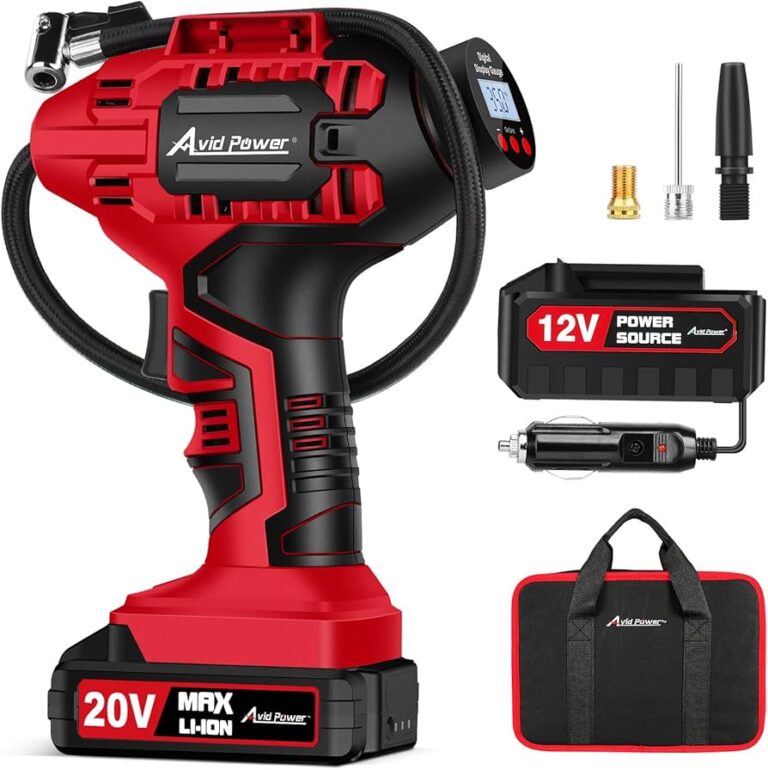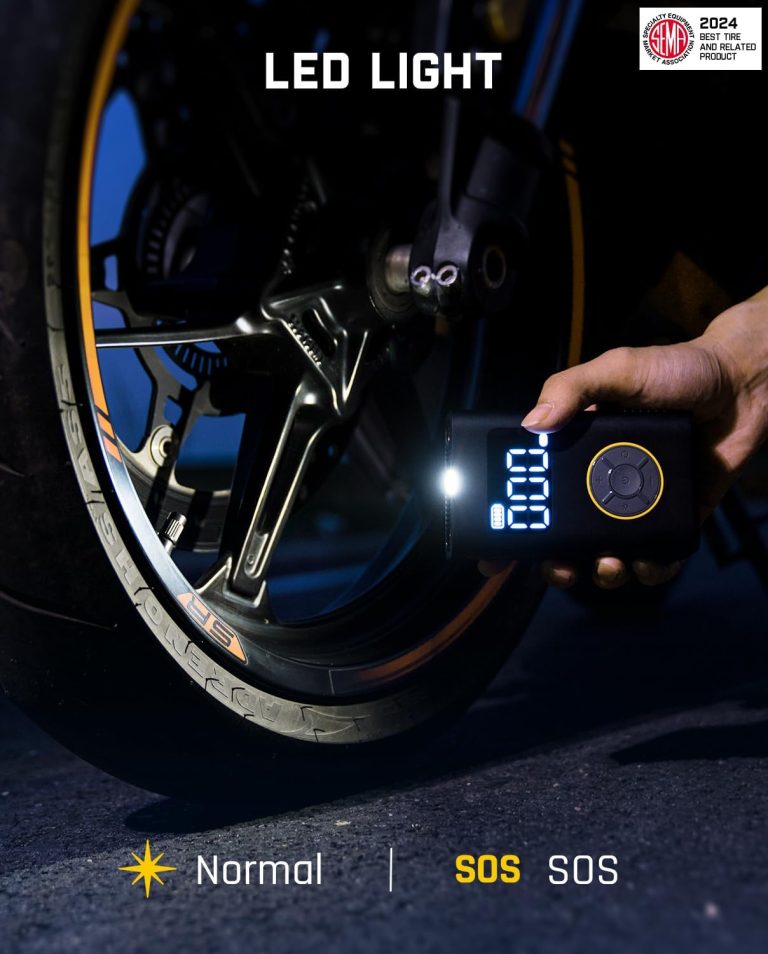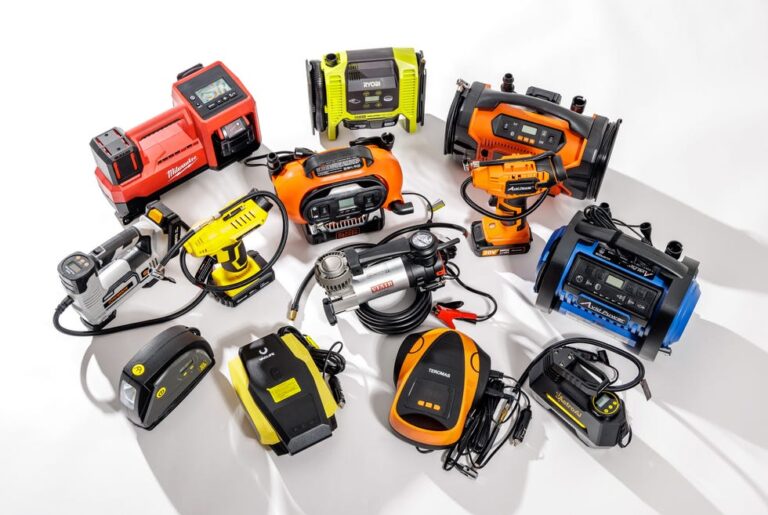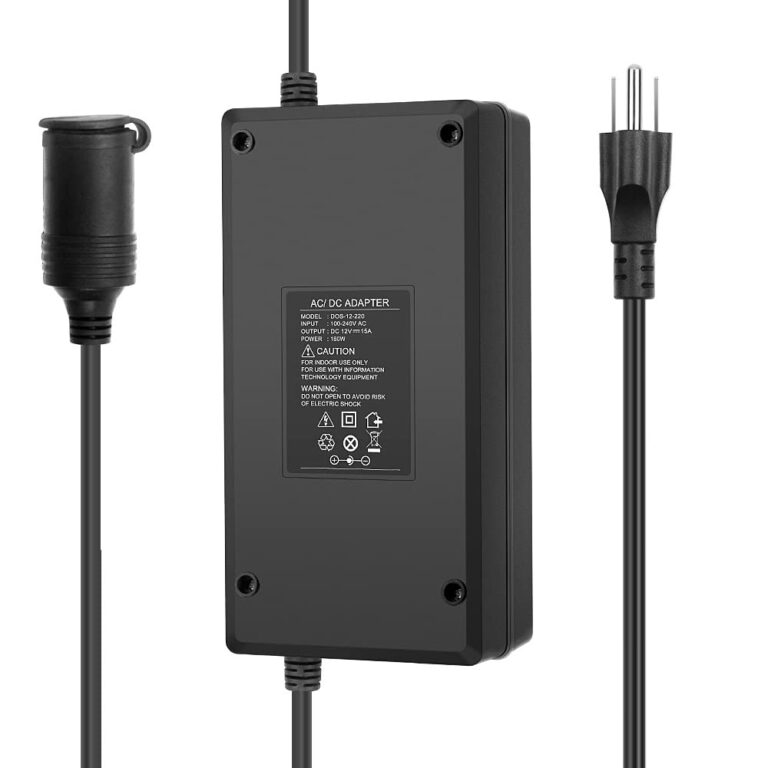Best Car Tire Inflators Under $50 – Top Affordable Picks For Your Vehicle
Proper tire inflation is critical for safety, fuel economy, and preventing premature tire wear. When tires are underinflated, the tread wears faster and heat builds up which can lead to blowouts. Underinflated tires also create more rolling resistance which reduces gas mileage.
It’s recommended to check your tire pressure at least once per month and before long road trips. An inflator allows you to easily maintain the manufacturer’s recommended tire pressure whenever you need to add air. Portable inflators plug into your car’s power outlet and are compact to store in your trunk.
While most gas stations have an air pump, the quality can be hit or miss. Investing in your own tire inflator ensures you have a reliable air source whenever and wherever you need it. This guide covers the top-rated tire inflators under $50, making it easy to find an affordable inflator for your vehicle.
What to Consider When Buying a Tire Inflator
When shopping for the best tire inflator under $50, there are several key factors to consider:
Desired Features
- Pressure gauge – An integrated or digital pressure gauge allows you to monitor the air pressure and inflate to the proper PSI. Models without a gauge require manually checking pressure with a separate tire gauge.
- Automatic shut-off – This safety feature automatically stops airflow when the target pressure is reached, preventing overinflation.
- Cord length – Longer power cords from 10-25 feet provide more range for mobility around a tire. Short cords limit maneuverability.
- Portability – Compact and lightweight designs under 5 pounds are easy to store and carry to inflate tires on the go. Larger stationary models may only be suitable for a garage or your vehicle’s trunk.
Accuracy and Ease of Inflation
The accuracy of the pressure gauge and ease of getting a tire inflated quickly are critical. Digital displays tend to be more precise than analog gauges. Quick-connect chucks make attaching to tire valves simple and fast. Units that struggle to inflate or don’t consistently hit the target pressure should be avoided.
Durability and Build Quality
For longevity, tire inflators must withstand regular use and resist wear and tear. Solid construction with metal housing protects internal components. Air hoses that kink or plastic fittings that easily break will undermine performance. Professional-grade materials ensure the inflator will last for years.
Reviews of Top Budget Tire Inflators
When looking for the best tire inflator under $50, three models stand out for their performance, durability, and value.
Epauto 12V Digital Tire Inflator
The Epauto 12V inflator is one of the top-rated budget tire inflators. It plugs into your car’s 12V outlet and has a simple, easy-to-read digital display. The Epauto can inflate a flat tire in under 5 minutes and shuts off automatically when it reaches the pressure you set. It comes with additional nozzle attachments for inflating sports equipment and air mattresses.
Customers love how quickly and reliably the Epauto inflates tires. It’s compact and portable design makes it easy to store in your trunk. The only downside is that the power cord is a bit short. Overall, the Epauto 12V inflator is a great value pick under $50.

Slime 40047 12-Volt Digital Tire Inflator
Slime is a leading brand in tire care, and their 40047 inflator is perfect for topping off your tires or filling a flat. It has an automatic shut-off when reaching the preset PSI. The easy-to-read digital display lets you dial in the exact pressure needed.
This inflator works fast, inflating most car tires in 3 minutes or less. The nozzle fits both standard tire valves and inflatable items with a needle nozzle adapter included. It has a lighted pressure gauge for visibility at night. Overall, the Slime 40047 is one of the best compact portable inflators.
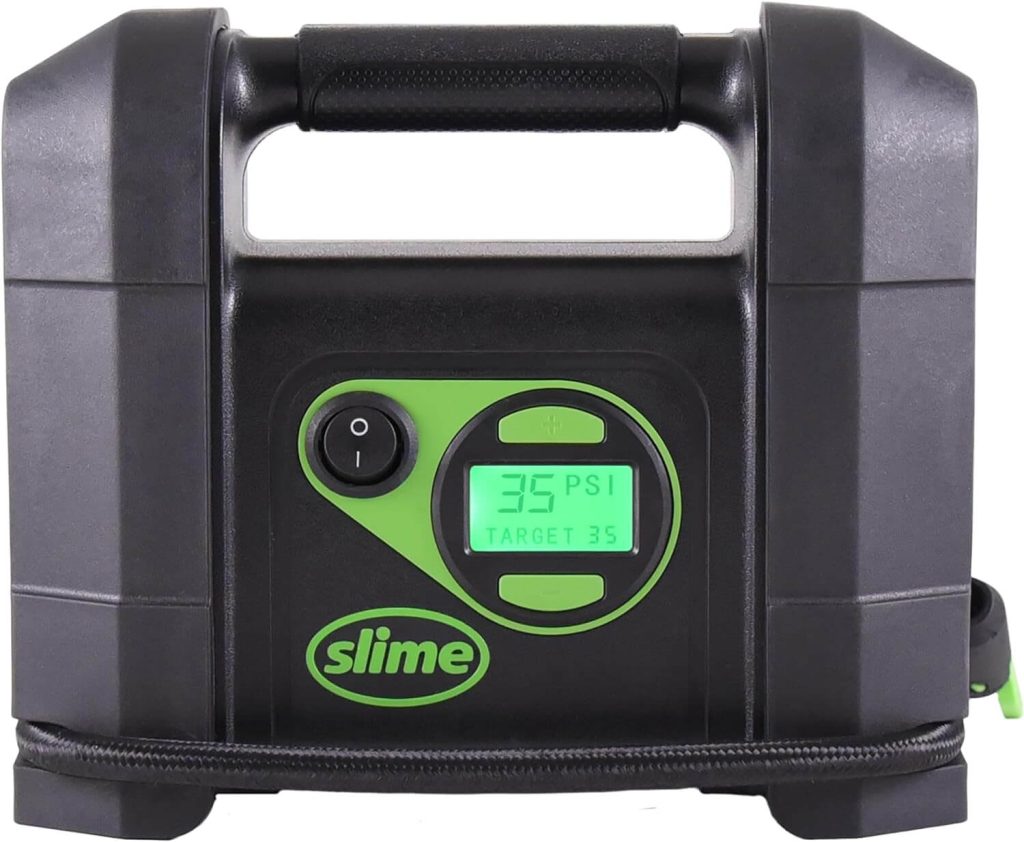
Kensun 12V DC Portable Air Compressor Tire Inflator
For a little more power, the Kensun portable compressor is an excellent choice. It plugs into any 12V car outlet and can inflate a mid-size tire from flat to 30 PSI in under 5 minutes. It auto-shuts off at your preset pressure.
The Kensun has a sturdy metal housing and an easy-to-read analog display. It comes with additional nozzle tips for balls, air beds, and other inflatables. An extension cord lets you reach all four tires from one outlet. For a bit more money, the powerful Kensun air compressor is worth considering.
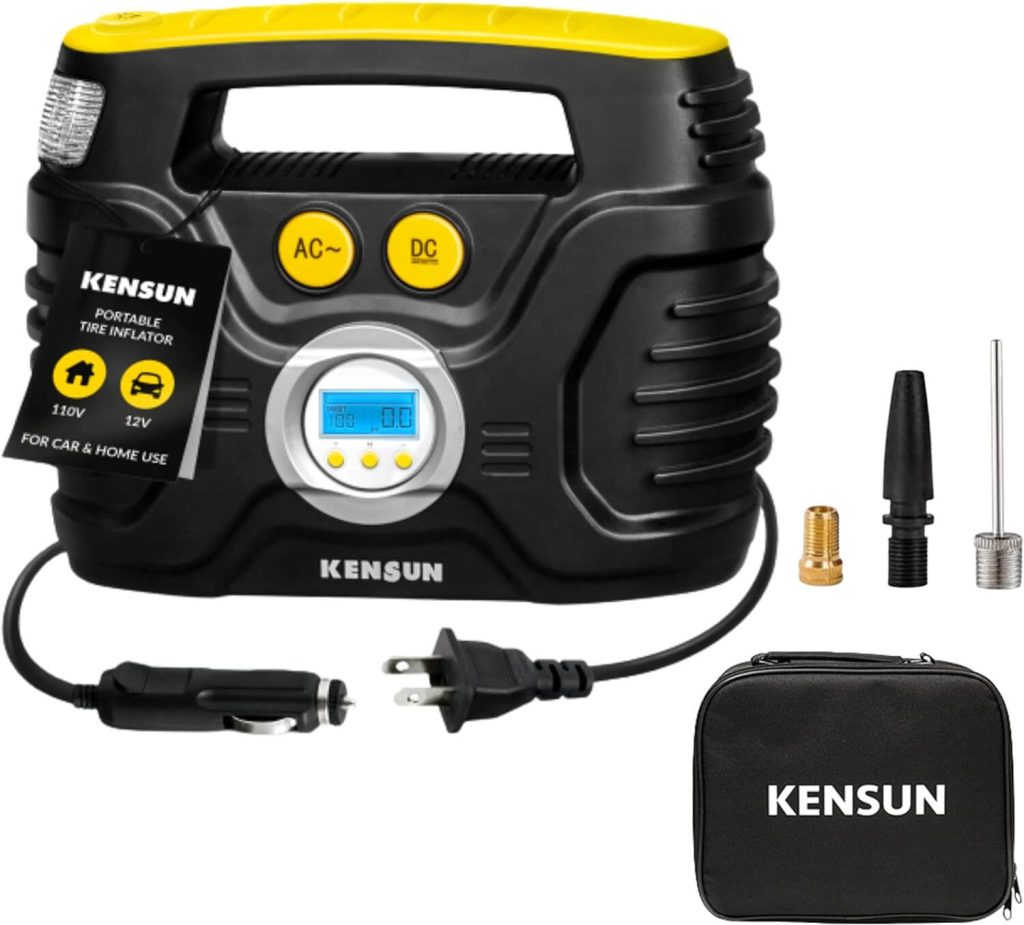
Portable vs. Fixed Tire Inflators
Portable tire inflators offer the benefit of convenience thanks to their compact size and cordless operation. Most portable units run off rechargeable batteries, allowing you to inflate tires anywhere without having to find a power source. This makes them ideal for keeping in your vehicle for emergency tire inflation when out on the road.
Portable inflators are typically very lightweight, usually under 5 pounds. This compact size means you can easily store them in your trunk or backseat. However, the tradeoff for portability is that battery-powered models may not be as powerful or durable as their full-sized counterparts. Portable units generally have lower maximum psi ratings and slower inflation times compared to heavy duty garage or wall mount inflators. The batteries can lose charging capacity over time as well.
Fixed inflators designed for permanent mounting on a wall or workbench offer much stronger inflation power and faster fill times. Large tank-style compressors are capable of inflating even large truck tires thanks to pressures over 100 psi. These heavy duty units are built to last years of regular use. The downside is that they require installation and a nearby power source to operate.
Larger fixed inflators may have auto shutoff features to prevent over-inflation. They often accommodate inflator gauges for precise pressure measurement. However, all this power and durability comes at the cost of reduced portability. Overall, portable cordless inflators provide flexibility and ease of use for everyday inflation needs, while fixed inflators offer maximum inflation power for frequent tire fill ups. Consider which benefits match your expected usage when choosing between portable and fixed tire inflators.
Using Tire Inflators Safely
When using a tire inflator, it’s important to follow the manufacturer’s instructions for safe operation. Here are some key safety tips:
- Read the user manual thoroughly and follow all directions. Don’t skip steps or take shortcuts. Understanding the proper operating procedures will help prevent accidents or damage.
- Always check for leaks, damage, or frayed cords before using your tire inflator. Look for cracks, loose connections, or other signs of wear. Damaged equipment can be dangerous. Replace accessories like hoses or connectors if needed.
- Use the recommended PSI (tire pressure) levels for your specific vehicle make and model. The proper inflation amount will be listed in the owner’s manual or on a sticker inside the driver’s side door jamb. Over or under-inflating tires can affect handling, braking, and fuel economy.
- Don’t leave the inflator running unattended. Remain present the entire time it’s operating. Turn it off immediately if you notice any problems or abnormal noises.
- Avoid running the inflator for more than 10 minutes consecutively, which can cause overheating. Let the unit cool down between uses. Don’t exceed the duty cycle recommendations.
- Make sure the inflator is on a flat, stable surface when in use. Secure hoses neatly without kinks. Don’t let the cords suspend or hang where they could become tangled.
- Check tire pressure frequently with an accurate gauge. Add air as needed to maintain the manufacturer’s recommended PSI. Consistent inflation maximizes tire performance and life.
- Store inflators safely in a temperate, dry location away from dirt, moisture and extreme temps. Transport them securely to avoid damage.
Following basic safety protocols helps ensure your tire inflator operates reliably for years. Take the time to use it correctly. Proper inflation keeps your vehicle tires in optimal shape.
Maintaining Your Tire Inflator
Keeping your tire inflator in good working condition ensures accuracy and safety when using it. Here are some tips for maintenance:
- Cleaning dust and debris – Over time, dust and dirt can build up on your tire inflator which can affect its performance. Wipe down the outer casing and inspect the air filter regularly. Replace filters as needed.
- Storing properly when not in use – Keep your tire inflator in a clean, dry location when not using it. Avoid storing it directly on concrete garage floors which can lead to moisture damage.
- Checking electrical cords and air hoses – Inspect cords and hoses for wear, cracks, or damage. Frayed wires can present a shock hazard. Dry, cracked rubber hoses can lead to air leaks. Replace damaged parts right away.
- Periodic accuracy checks – Every month or so, test your inflator’s pressure readings against a known accurate gauge like at a gas station. If the readings are off, the inflator may need to be recalibrated.
Proper care and maintenance ensures your tire inflator provides accurate readings and inflation for the long haul. Periodically inspecting for damage, testing for accuracy, cleaning dust build up, and storing appropriately when not in use can add years to your inflator’s life.
When to Use a Gas Station Inflator
Even with the best portable tire inflator, there are times when using a gas station inflator is necessary or more convenient. Here are some situations when it makes sense to use the air compressor at a gas station or auto shop rather than your own inflator:
- If you need air immediately while away from home – Portable inflators are useful to keep in your vehicle for on-the-go top-offs and emergency fill-ups. But if you discover you have very low tire pressure while out running errands or on a road trip, a gas station inflator can provide a quick solution to get you safely back on the road. This avoids having to unpack and set up your inflator on the spot.
- If inflating truck or commercial tires – Most affordable portable inflators for personal vehicles cannot achieve the high psi levels needed for larger truck, SUV, and commercial tires. Gas station compressors are more powerful and can fill to higher psi ratings.
- If your inflator can’t achieve high psi – Similarly, if your inflator has limitations on the maximum psi it can handle, a gas station may be necessary for fill ups requiring very high pressures. Check your inflator’s max pressure rating.
- If you need to measure tire pressure – Many gas station air hoses have pressure gauges built in to obtain an accurate reading of your current tire pressure. This allows you to inflate to the precise recommended level.
- If you don’t want to drain your inflator battery – For battery powered inflators, frequent full tire fill ups can drain the battery quickly. Using a gas station compressor prevents overuse and saves your inflator battery life.
So while a portable compressor is extremely convenient for at-home tire inflation needs, gas station air hoses still serve an important purpose. In certain situations, utilizing them is the wisest and most efficient choice.
Top Accessories and Add-Ons
A good tire inflator is just the beginning. Here are some of the top accessories and add-ons to consider to make tire inflation even easier:
Tire Pressure Gauges
An accurate tire pressure gauge is essential for properly inflating your tires. The gauges built into most inflators are convenient but often unreliable. Invest in a quality standalone digital gauge for precise readings. Look for one that reads in 0.5 psi or 0.1 psi increments for best accuracy.
Extension Hoses and Nozzles
The short hoses on inflators limit where you can reach your tires. Adding a 1-3 foot rubber or coiled hose extension provides more flexibility. Angled, extendable, or swiveling nozzles also make it easier to get a tight seal on the tire valve stem.
Portable Work Lights
Trying to use a tire inflator in low light or at night is frustrating. Many inflators have built-in LED lamps, but they are dim. Bring much more illumination to the task with a bright portable work light or flashlight. Hands-free magnetic models are particularly convenient.
Carrying Cases
For portable inflators, a carrying case adds protection and convenience. Look for a bag or case with pockets to hold the inflator, cable, accessories, and manuals together in one place. Molded plastic cases offer the most protection. Durable nylon soft cases are lighter weight.
Power Inverters
For maximum flexibility, consider adding a DC to AC power inverter to your kit. This allows you to power AC inflators from your car’s 12V DC outlet. But beware, inverters draw a lot of current and can drain your car battery quickly.
With the right accessories, you can make your tire inflator much more convenient and effective to use. The small additional investment is well worth it for the benefits. Just be sure to get quality accessories designed for automotive use.
FAQs
What is the proper PSI to inflate my tires?
The recommended PSI for your tires is usually located on a sticker inside the driver’s side door jamb or in your owner’s manual. As a general guideline, most passenger vehicle tires perform best around 30-35 PSI. Underinflated tires can cause poor handling, reduced fuel economy, and uneven tread wear. Overinflated tires provide less traction and ride comfort.
Can I use a tire inflator in an emergency or to temporarily fix a flat?
Portable tire inflators can be handy for temporarily reinflating a flat tire so you can drive to a repair shop. However, this is only a short-term fix and the tire should still be properly repaired or replaced. Avoid driving long distances on a temporary inflator fix.
Are gas station inflators as good as buying my own electric or battery powered inflator?
Gas station inflators are convenient when you’re out and about, but they have some downsides. They are often slow, may not fill to higher pressures, and could have been used by other vehicles with worn cords/nozzles. An electric or battery powered inflator lets you quickly and easily top off your tires anytime at home. They’re also handy for sports equipment, air mattresses, etc.
How can I tell when my tire inflator needs maintenance or replacement parts?
Check inflator nozzles and hoses for cracks or damage. Replace if air leaks out. Inflator motors can wear out over time. Listen for odd noises or lack of power. Replace filters periodically. Keep your inflator clean and store properly to maximize its lifespan.
What accessories can enhance my tire inflator experience?
Helpful add-ons include an air pressure gauge for precise inflation, a digital tire inflator with settings, a cordless inflator for mobility, a tire sealant canister for emergencies, and a carrying case to keep things organized.
Conclusion
When looking for the best car tire inflator under $50, there are a few key things to consider. Based on the reviews and information provided, the Viar 400P-RV Automatic Portable Compressor stands out as a top choice for most drivers. Here’s a summary of why it’s recommended:
- Highly rated and reviewed – The Viar has hundreds of positive reviews and 4+ star ratings across retailers. It’s a popular choice that’s been road tested.
- Automatic shut off – The auto shut off when reaching the set PSI takes the guesswork out of inflation. No more over or under inflated tires.
- Portable and versatile – Its compact size makes it easy to stow in the trunk or cargo area. It can handle tires on cars, bikes, ATVs, and more.
- Dual inflator heads – The dual heads allow you to use the inflator on car tires, balls, air mattresses and more. It tackles multiple jobs.
- Digital display – The easy-to-read digital display shows tire pressure, so you always know the PSI.
- Good value – It delivers professional-level performance at an affordable price under $50.
For drivers that do a mix of city and highway driving, need an inflator for multiple uses, and want reliability without a high cost, the Viar 400P-RV is an excellent choice for under $50. It has the right mix of portability, accuracy, versatility and value.

